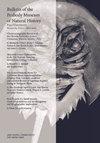Systematics and Taxonomy of the Snubnose Darter, Etheostoma simoterum (Cope)
IF 0.9
4区 哲学
Q2 BIODIVERSITY CONSERVATION
引用次数: 2
Abstract
Abstract A taxonomic revision of Etheostoma simoterum (Cope) published in 2007 resulted in the recognition of six species, with two species distributed in the Tennessee River system. A newly defined Etheostoma simoterum was restricted to populations in the Holston River above the confluence of the North and South Forks, and the Russell Fork system of the Ohio River drainage. A newly described species, Etheostoma tennesseense Powers & Mayden, included all other populations historically considered Etheostoma simoterum in the Tennessee River system from near the mouth of the Duck River upstream to the Clinch River, including the Holston River below the forks. A subsequent study utilizing molecular phylogenetics and analysis of male nuptial coloration did not support the recognition of Etheostoma tennesseense. Molecular phylogenies resolve both Etheostoma simoterum and Etheostoma tennesseense as paraphyletic. In addition, it was determined that male coloration patterns are not diagnostic for the more restricted and new definition of Etheostoma simoterum. In this study, we examine the systematics of Etheostoma simoterum using meristic traits sampled from more than 1,000 specimens, including Cope's syntype series of Hyostoma simoterum and Powers and Mayden's paratopotype series of Etheostoma tennesseense. Our results show a pattern of clinal variation, where meristic traits are higher in the in the lower Tennessee River system. Comparisons of populations above and below the forks of the Holston River show no differences in meristic traits, but populations sampled from the Watauga River system exhibit scale counts lower than any other population of Etheostoma simoterum. We cannot reject the hypothesis that Etheostoma tennesseense is conspecific with the specimens that comprise the Hyostoma simoterum syntype series. Based on both morphological and molecular species delimitation strategies, we treat Etheostoma tennesseense as a synonym of Etheostoma simoterum.鼻烟壶的系统学与分类学
摘要2007年发表的一篇Etheostoma simoterum (Cope)的分类学修订,鉴定出6种,其中2种分布在田纳西河水系。一种新定义的Etheostoma simoterum被限制在霍尔斯顿河南北福克斯汇合处以上的种群,以及俄亥俄河流域的罗素福克系统。一个新发现的物种,Etheostoma Tennessee senense Powers & Mayden,包括了田纳西河系统中从鸭子河河口附近上游到Clinch河的所有其他历史上被认为是Etheostoma simoterum的种群,包括分叉以下的霍尔斯顿河。随后的一项研究利用分子系统发育和分析雄性婚礼颜色不支持识别Etheostoma田纳西。分子系统发育表明simmoterum和Etheostoma tenseense都是副葡萄生长的。此外,还确定了雄性颜色模式不能用于诊断更严格的新定义的Etheostoma simoterum。在这项研究中,我们利用从1000多个标本中采集的分生性状,包括Cope’s syostoma simmoterum的模式系列和Powers和Mayden’s mattheostoma tenseense的副模式系列,对simoterum的系统分类进行了研究。我们的结果显示了一种临床变异模式,其中分生性状在田纳西河下游系统中较高。对霍尔斯顿河支流上下的种群进行比较,发现分生性状没有差异,但从瓦托加河系统取样的种群显示出比其他任何种群都低的规模计数。我们不能拒绝这样一种假设,即田纳西舌骨瘤与构成simoterum舌骨瘤模式系列的标本是同源的。基于形态学和分子物种划分策略,我们将Etheostoma tensenense视为Etheostoma simoterum的同义词。
本文章由计算机程序翻译,如有差异,请以英文原文为准。
求助全文
约1分钟内获得全文
求助全文
来源期刊

Bulletin of the Peabody Museum of Natural History
BIODIVERSITY CONSERVATION-ECOLOGY
CiteScore
2.40
自引率
0.00%
发文量
6
审稿时长
>12 weeks
期刊介绍:
The Bulletin of the Peabody Museum of Natural History publishes original research based on specimens, artifacts and related materials maintained in the collections of the Yale Peabody Museum of Natural History’s curatorial divisions. The Bulletin is published twice a year, in April and October.
 求助内容:
求助内容: 应助结果提醒方式:
应助结果提醒方式:


